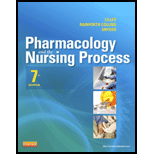
To describe:
Anatomy and physiology of the heart, cardiac electrophysiology, including normal condition patterns, rate, and rhythm.
Concept introduction:
Dysrhythmia is one of the major symptoms seen in heart failure, where the abnormal rhythm of the heart is seen. In many conditions such as myocardial infarction, coronary artery disease, and even in cardiac surgery dysrhythmia occurs. Now, Vaughan Williams classifications of the antidysrhythmic drug are used that include four major classes of drugs. The Vaughan Williams drugs classification are I (Ia, Ib, Ic), II, III, IV that are used for various dysrhythmias.
Explanation of Solution
The heart is a unique organ that pumps oxygenated blood to organs and to bring back de-oxygenated blood to lungs to repeat the cycle. The heart is located in the thoracic cavity in the middle of the lungs. The heart is made up of four chambers, two ventricles, and two atria. The heart is one of the vital organs that can be subjected to various symptoms like dysrhythmias, myocardial infarction, and coronary artery disease. The study of the electrical impulses of the heart is termed to be cardiac electrophysiology. The electrical impulses make the heart to beat, the motion of the heart is by rushing of sodium ions and potassium into the heart cells makes an electrical flux that makes the calcium ions to influx. The influx of the calcium ions makes the heart to contract and this motion is repeated in all the cells of the heart to make it beat. The beat is termed to be the cardiac rhythm and it can be monitored by an ECG. Any abnormalities in the rhythm lead to dysrhythmias, heart failure, and death. In the normal cardiac pattern, the SA will be traveling to the atria and then lowers to the ventricles, these patterns can be observed in the ECG graph. The normal heart rates range from 60 to 100 beats per minute.
The anatomy and physiology of the heart, cardiac electrophysiology, including normal condition patterns, rate, and rhythm are discussed.
Want to see more full solutions like this?
Chapter 25 Solutions
Pharmacology and the Nursing Process
- • Define obstetric emergencies and state and briefly explain any two (2) maternal, foetal, and obstetric complications that require immediate intervention. • Explain how mental health services can be effectively integrated into maternal and child health, viz-a-viz early childhood development. • Enumerate any four (4) foetal malpresentations in pregnancy and briefly explain their implication in labour while also highlighting their causes and possible complications.arrow_forward• Briefly highlight the physiological changes in pregnancy in relation to cardiovascular and endocrine systems, as well as the uterus and the skin. • Discuss the current antenatal care approach for pregnant women and provide the highlight of activities conducted during woman’s antenatal visit, clearly describing the steps needed for successful antenatal care. • Enumerate any three (3) abnormalities related to placental development and their implications to pregnancy or childbirth.arrow_forward58 64. Rhythm: Clues: Rhythm: Clues: 62 Rhythm QRS Complex Rates PRI Interpretation Rhythm: P wave QRS Complex Rate PRI Interpretation Rhythm: Clues: Rhythm P wave: QRS Complex Rate PRI Interpretation: Rhythm: P wave: QRS Complex: Rate: Interpretation: 67 Rhythm: P wave: QRS Complex: Rate: PRI Interpretation: Rhythm: P wave: QRS Complex: Rate: PRI Interpretation: 68 Rhythm P waves QRS Complex Rate PRI Interpretation Rhythm P wave QRS Complex Rhythm: P wave QRS Complex: Rate PRI Interpretations Rate PRI Interpretationarrow_forward
- 51. 52. 53. Rhythm: Clues: Rhythm: Clues: Rhythm: Clues:arrow_forwardRegularity- Rate- P waves- PRI- QRS- Interpretation- atrial dysrthmia,junctional dysrthymia,and ventricular rhythm,heart blocks,normal sinus,PVCarrow_forwardnormal sinus,atrial dysrthmia,junctional dysrthymia,and ventricular rhythm,heart blocks,PVCarrow_forward
- normal sinus,atrial dysrthmia,junctional dysrthymia,and ventricular rhythm,heart blocksarrow_forwardA 40-year-old male farmer was rushed to an ER with complaints of fever, abdominal pain/tenderness, nausea and vomiting. Clinical examination and investigations revealed diagnosis of typhoid perforation and he was booked for exploratory laparotomy. Explain in detail the pre - operative care of this patient.arrow_forwardAs a nursing student wanting to do preceptorship at ICU or ER, answer the following question: Why are you requesting this site? How will this unit meet your learning needs?How will this unit contribute to your professional goals?arrow_forward
- As a nursing student wanting to do preceptorship at the cancer clinic. Answer the following question. Why are you requesting this unit? How will this site meet your learning needs? How will this unit contribute to your professional goals?arrow_forward40. Rhythm (regular or irregular):. Rate: P wave: PR interval: QRS: Interpretation:arrow_forwarddetermine ventricular rhythm stripsarrow_forward
 Phlebotomy EssentialsNursingISBN:9781451194524Author:Ruth McCall, Cathee M. Tankersley MT(ASCP)Publisher:JONES+BARTLETT PUBLISHERS, INC.
Phlebotomy EssentialsNursingISBN:9781451194524Author:Ruth McCall, Cathee M. Tankersley MT(ASCP)Publisher:JONES+BARTLETT PUBLISHERS, INC. Gould's Pathophysiology for the Health Profession...NursingISBN:9780323414425Author:Robert J Hubert BSPublisher:Saunders
Gould's Pathophysiology for the Health Profession...NursingISBN:9780323414425Author:Robert J Hubert BSPublisher:Saunders Fundamentals Of NursingNursingISBN:9781496362179Author:Taylor, Carol (carol R.), LYNN, Pamela (pamela Barbara), Bartlett, Jennifer L.Publisher:Wolters Kluwer,
Fundamentals Of NursingNursingISBN:9781496362179Author:Taylor, Carol (carol R.), LYNN, Pamela (pamela Barbara), Bartlett, Jennifer L.Publisher:Wolters Kluwer, Fundamentals of Nursing, 9eNursingISBN:9780323327404Author:Patricia A. Potter RN MSN PhD FAAN, Anne Griffin Perry RN EdD FAAN, Patricia Stockert RN BSN MS PhD, Amy Hall RN BSN MS PhD CNEPublisher:Elsevier Science
Fundamentals of Nursing, 9eNursingISBN:9780323327404Author:Patricia A. Potter RN MSN PhD FAAN, Anne Griffin Perry RN EdD FAAN, Patricia Stockert RN BSN MS PhD, Amy Hall RN BSN MS PhD CNEPublisher:Elsevier Science Study Guide for Gould's Pathophysiology for the H...NursingISBN:9780323414142Author:Hubert BS, Robert J; VanMeter PhD, Karin C.Publisher:Saunders
Study Guide for Gould's Pathophysiology for the H...NursingISBN:9780323414142Author:Hubert BS, Robert J; VanMeter PhD, Karin C.Publisher:Saunders Issues and Ethics in the Helping Professions (Min...NursingISBN:9781337406291Author:Gerald Corey, Marianne Schneider Corey, Cindy CoreyPublisher:Cengage Learning
Issues and Ethics in the Helping Professions (Min...NursingISBN:9781337406291Author:Gerald Corey, Marianne Schneider Corey, Cindy CoreyPublisher:Cengage Learning





